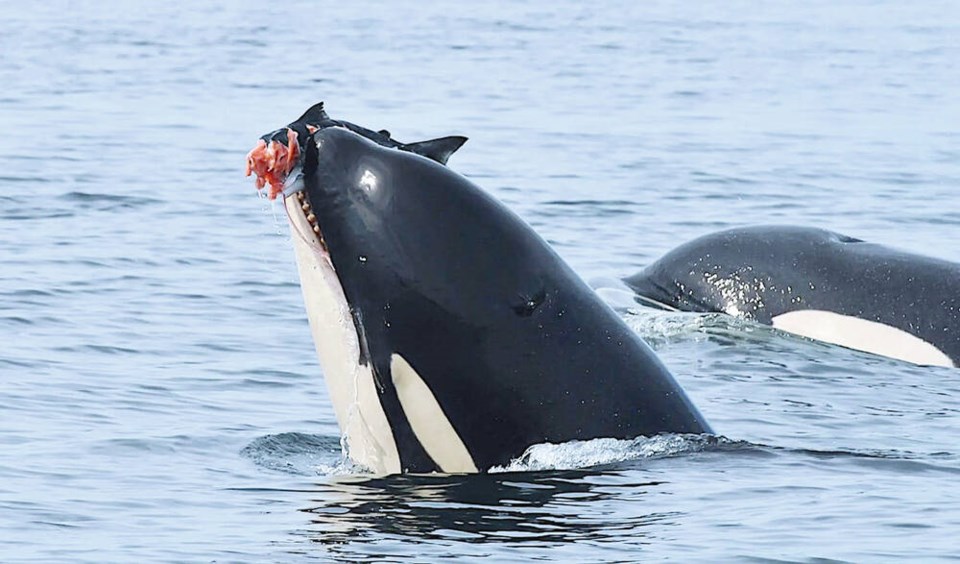A commentary by cetacean scientists with Raincoast Conservation Foundation. They co-direct Raincoast’s Cetacean Conservation Research Program.
As the saying goes, everyone is entitled to their own opinion, but not their own facts. When it comes to our iconic southern resident killer whales, one of the most thoroughly studied whale populations on the planet, basic facts about their natural history, ecology and biology have been well established through more than 40 years of scientific research.
Gwyn Morgan’s recent commentary, “Orcas, poachers and our threatened salmon industry,” revealed a troubling misunderstanding of killer whales, wild salmon and the fundamentals of wildlife science.
To set the record straight: Southern residents are not “the only orcas in the world that eat salmon.” They are not even the only salmon-eating killer whales in British Columbia. B.C. is home to the salmon-eating northern resident killer whale population, and Alaska has its own salmon-eating killer whales as well.
Northern and southern resident killer whales and their mammal-eating cousins, known as Bigg’s killer whales, exhibit unique genetics, behaviours, physical traits and acoustic dialects.
Despite sharing overlapping habitats, they remain socially and reproductively isolated, meaning they never interbreed or interact. A recent study proposed that Bigg’s killer whales in the North Pacific be recognized as distinct species, separate from all other killer whales worldwide.
While this proposal has yet to be accepted, it underscores the importance of killer whales’ distinct cultural traditions — such as communication, social behaviour and diet, all unique adaptations that have allowed killer whales to thrive in different environments.
Historically, the southern residents numbered over 200, but this dropped dramatically in the 1960s and early 1970s due to the capture of whales for marine parks.
By 1974, only 71 remained. The population rebounded to 98 whales by the mid-1990s, but has since declined by about 25 per cent. Today, there are just 74 individuals left, and they are classified as endangered under both the Canadian Species at Risk Act (SARA) and the U.S. Endangered Species Act (ESA).
This time, their decline is mainly due to habitat destruction, including a dwindling supply of large chinook salmon, their primary food source. Rather than being an “addiction to salmon,” as Morgan claims, their diet is the manifestation of an evolved trait of killer whale populations to specialize on specific prey — a feature of their biology that has served them well in the past.
To exacerbate the reduced availability of large chinook, other factors such as exposure to contaminants and underwater vessel noise that interferes with their ability to forage efficiently, further hinder their recovery. These threats also act synergistically, exacerbating one another.
While some argue that fishery closures hurt local economies, they are necessary to protect wild chinook salmon populations, which are equally in crisis due to overfishing, habitat loss, hatcheries and climate change. Without salmon, the southern residents have no future. Moreover, the long-term health of fisheries is also at risk as salmon populations decline.
And contrary to Morgan’s assertion that there is no credible scientific evidence behind the federal decision to phase out open-net salmon farms by 2029, 16 leading Canadian academics publicly criticized the 2023 Fisheries and Oceans Canada report he cited.
There is extensive peer-reviewed research showing the risk that sea lice and disease from salmon farms present to wild salmon, salmon that are vital for fisheries.
Southern resident killer whales are indeed on a path to extinction, as Morgan pointed out, but this is not an illustration of Darwin’s law, as he would have us believe.
It is an illustration of economic growth at any cost and political inertia.
If they are to recover, the Canadian government needs to use an emergency order under SARA to halt the rapid degradation of Salish Sea waters where southern residents feed.
The loss of this population would mean more than the disappearance of 74 killer whales. It would mark the extinction of the population’s culture, a way of life passed down through generations. Further, it would signal that our manner of living undermines the survival of other living creatures that share our region.
Protecting the southern residents is about safeguarding a cultural legacy and heeding the warning signs that our footprint in and around the Salish Sea is not sustainable.
>>> To comment on this article, write a letter to the editor: [email protected]



